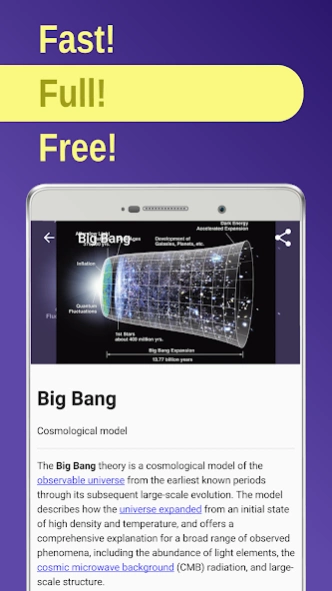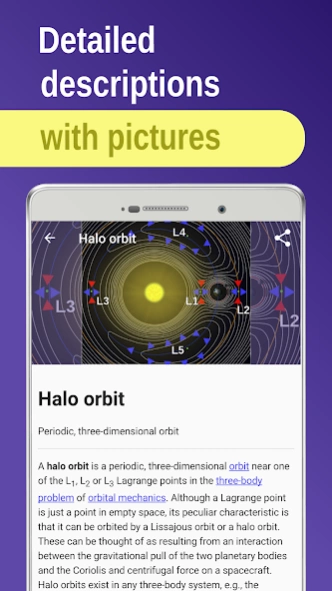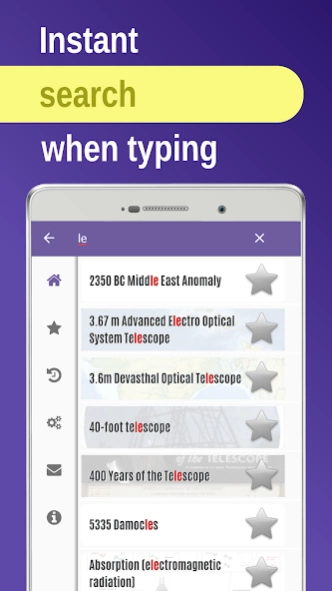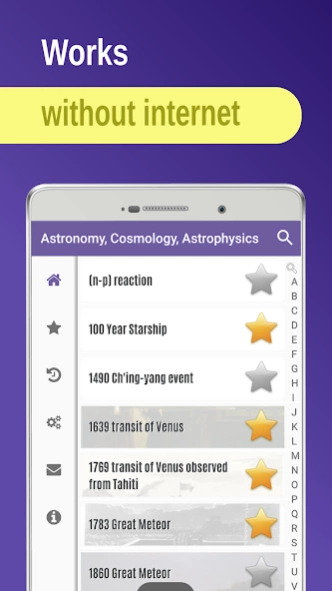Astronomy, astrophysics 3.8.5
Free Version
Publisher Description
Astronomy, astrophysics - Universe: asteroids, exoplanet, deep space, dwarf planets, supernova
A big scientific encyclopedia "Astronomy, Cosmology, Astrophysics": universe, asteroids, exoplanet, deep space, dwarf planets, supernova, constellation.
Astronomy is a natural science that studies celestial objects and phenomena. Objects of interest include planets, moons, stars, nebulae, galaxies, and comets. Relevant phenomena include supernova explosions, gamma ray bursts, quasars, blazars, pulsars, and cosmic microwave background radiation.
Cosmology is a branch of astronomy concerned with the studies of the origin and evolution of the universe, from the Big Bang to today and on into the future.
Astrophysics is a science that employs the methods and principles of physics in the study of astronomical objects and phenomena. Among the subjects studied are the Sun, other stars, galaxies, extrasolar planets, the interstellar medium and the cosmic microwave background.
A galaxy is a gravitationally bound system of stars, stellar remnants, interstellar gas, dust, and dark matter. Galaxies range in size from dwarfs with just a few hundred million stars to giants with one hundred trillion stars, each orbiting its galaxy's center of mass.
The Milky Way is the galaxy that contains our Solar System, with the name describing the galaxy's appearance from Earth: a hazy band of light seen in the night sky formed from stars that cannot be individually distinguished by the naked eye.
A constellation is an area on the celestial sphere in which a group of visible stars forms a perceived outline or pattern, typically representing an animal, mythological person or creature, or an inanimate object.
Asteroids are minor planets, especially of the inner Solar System. Larger asteroids have also been called planetoids. These terms have historically been applied to any astronomical object orbiting the Sun that did not resolve into a disc in a telescope and was not observed to have characteristics of an active comet such as a tail.
An exoplanet or extrasolar planet is a planet outside the Solar System. There are many methods of detecting exoplanets. Transit photometry and Doppler spectroscopy have found the most, but these methods suffer from a clear observational bias favoring the detection of planets near the star.
A supernova is a powerful and luminous stellar explosion. This transient astronomical event occurs during the last evolutionary stages of a massive star or when a white dwarf is triggered into runaway nuclear fusion. The original object, called the progenitor, either collapses to a neutron star or black hole, or is completely destroyed.
A dwarf planet is a planetary-mass object that does not dominate its region of space (as a planet does) and is not a satellite. That is, it is in direct orbit of the Sun and is massive enough to be plastic – for its gravity to maintain it in a hydrostatically equilibrious shape (usually a spheroid) – but has not cleared the neighborhood of its orbit of similar objects.
A black hole is a region of spacetime where gravity is so strong that nothing—no particles or even electromagnetic radiation such as light—can escape from it. The theory of general relativity predicts that a sufficiently compact mass can deform spacetime to form a black hole.
A quasar is an extremely luminous active galactic nucleus, in which a supermassive black hole with mass ranging from millions to billions of times the mass of the Sun is surrounded by a gaseous accretion disk.
This dictionary free offline:
• contains over 4500 definitions of characteristics and terms;
• ideal for professionals and students;
• advanced search function with autocomplete - search will start and predict word as you type;
• voice search;
• work offline - database packaged with the app, no data costs incurred when searching
"Astronomy, Cosmology, Astrophysics encyclopedia" is a complete free offline handbook of terminology, covers the most important terms and concepts.
About Astronomy, astrophysics
Astronomy, astrophysics is a free app for Android published in the Reference Tools list of apps, part of Education.
The company that develops Astronomy, astrophysics is 99 Dictionaries: The world of terms. The latest version released by its developer is 3.8.5.
To install Astronomy, astrophysics on your Android device, just click the green Continue To App button above to start the installation process. The app is listed on our website since 2024-01-19 and was downloaded 0 times. We have already checked if the download link is safe, however for your own protection we recommend that you scan the downloaded app with your antivirus. Your antivirus may detect the Astronomy, astrophysics as malware as malware if the download link to com.dictionary.astronomy.cosmology.astrophysics.encyclopedia is broken.
How to install Astronomy, astrophysics on your Android device:
- Click on the Continue To App button on our website. This will redirect you to Google Play.
- Once the Astronomy, astrophysics is shown in the Google Play listing of your Android device, you can start its download and installation. Tap on the Install button located below the search bar and to the right of the app icon.
- A pop-up window with the permissions required by Astronomy, astrophysics will be shown. Click on Accept to continue the process.
- Astronomy, astrophysics will be downloaded onto your device, displaying a progress. Once the download completes, the installation will start and you'll get a notification after the installation is finished.



